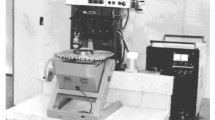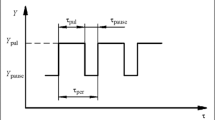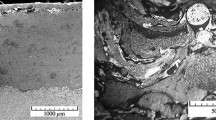An analysis of the regularities of electrocontact welding deposition of powders of self-fluxing alloys has been made. A model and an implementation technology for this process have been developed. Results of metallographic investigations and tribotechnical tests of the obtained coatings have been given. The adequacy of the developed model has been shown when using it in calculations of the regimes of electrocontact welding deposition of powder materials. It has been established that the structures of the obtained coatings correspond to the structures of wear-resistant antifriction coatings produced from melts with an initial temperature no more than 50–100°C higher than the melting point of the material of powder particles. Crystallization of these melts under forging conditions ensures the formation of fine graininess in the materials of coatings obtained from them, with the grains having somewhat smeared boundaries within which the hereditary structure of the material of the original powder may be preserved.
Similar content being viewed by others
References
A. I. Sidorov, Restoration of Machine Parts by Sputtering and Welding Deposition [in Russian], Mashinostroenie, Moscow (1987).
N. S. Penkin, A. N. Penkin, and V. M. Serbin, Fundamentals of Tribology and Triboengineering [in Russian], Mashinostroenie, Moscow (2008).
P. A. Vityaz′ et al., Theory and Practice of Deposition of Protective Coatings [in Russian], Belaruskaya Navuka, Minsk (1998).
M. A. Belotserkovskii, Technologies of Activated Flame Spraying of Antifriction Coatings [in Russian], Tekhnoprint, Minsk (2004).
K. E. Belyavin, I. A. Sosnovskii, and A. L. Khudolei, Induction heating in the processes of centrifugal deposition of coatings, Vestn. Fonda Fundam. Issled., No. 3(36), 70–87 (2013).
A. G. Grigor′yants, I. N. Shiganov, and A. I. Misyurov, Technological Processes of Laser Treatment [in Russian], MGTU im. N. É. Baumana, Moscow (2008).
N. N. Rykalin, A. A. Uglov, I. V. Zuev, and A. N. Kokora, Laser and Electron-Beam Treatment of Materials: A Handbook [in Russian], Mashinostroenie, Moscow (1985).
V. N. Gadalov, V. V. Samoilov, and A. I. Lytkin, Electric-spark coatings from nickel–chromium-based self-fluxing powders on high-speed steel, Fundam. Issled., No. 5, 43–45 (2009).
A. V. Sosnovskii, Deposition of Wear-Resistant Coatings by Electrocontact Fusion [in Russian], LAP LAMBERT Academic Publishing, Saarbrucken, Germany (2013).
Yu. M. Pleskachevskii, Principles of the technology of electrocontact sintering of nanostructured metallopolymer coatings for tribotechnical purposes, Svarka Rodstv. Tekhnol., Nos. 10–11, 72–79 (2013).
Powder Metallurgy. Terms and Definitions, GOST 17359-82.
N. N. Dorozhkin, V. A. Mironov, and A. A. Kot, Electrophysical Methods to Obtain Coatings from Metal Powders [in Russian], Zinatne, Riga (1985).
K. E. Belyavin et al., Theory and Practice of Pulsed Electric Current Sintering of Porous Powder Materials [in Russian], Remiko, Minsk (1997).
E. G. Grigor′ev and B. A. Kalin, Pulsed Electric Current Technology of Molding of Materials from Powders [in Russian], MIFI, Moscow (2008).
M. S. Boldin, Physical Principles of the Technology of Pulsed Electric Current Plasma Sintering of Powder Materials [in Russian], NNGU, Nizhny Novgorod (2012).
H. U. Kessel et al., "FAST" field assisted sintering technology — A new process for the production of metallic and ceramic sintering materials, Pulvermetallurgie: Wissenschaft Praxis, 22, 201–237 (2006).
O. Guillon et al., Field-assisted sintering technology/spark plasma sintering: Mechanisms, materials, and technology developments, Adv. Eng. Mater., 16, Issue 7, 830–849 (2014).
Z. A. Muni, U. Anselmi-Tamburini, and M. Ohyanagi, The effect of electric field and pressure on the synthesis and consolidation of materials: A review of the spark plasma sintering method, J. Mater. Sci., 41, 763–777 (2006).
Z. A. Muni, D. V. Quach, and M. Ohyanagi, Electric current activation of sintering: A review of the pulsed electric current sintering process, J. Am. Ceram. Soc., 94, No. 1, 1–19 (2011).
A. I. Raichenko, Principles of the Process of Sintering of Powders by Passing an Electric Current [in Russian], Metallurgiya, Moscow (1987).
B. B. Damaskin and O. A. Petrii, Introduction to Electrochemical Kinetics [in Russian], Vysshaya Shkola, Moscow (1983).
Yu. O. Kharlamov and M. A. Budag′yants, Physics, Chemistry, and Mechanics of the Surface of a Solid Body [in Russian], SUDU, Lugansk (2000).
Ch. Kittel, Introduction to Solid-State Physics [Russian translation], Nauka, Moscow (1978).
P. V. Pavlov and A. F. Khokhlov, Solid-State Physics [in Russian], Vysshaya Shkola, Moscow (2000).
I. Kh. Badamshin, Method for Determining the Elastic Modulus, RF Patent No. 2226266, Published 27.03.2004, Bull. No. 13.
I. Kh. Badamshin, From Four to One. Interatomic Interaction Forces and Strength of Materials [in Russian], Akademiya Estestvoznaniya, Moscow (2014).
A. Yu. Zakharov, Lattice Models of Statistical Physics [in Russian], NovGU, Novgorod (2006).
A. Yu. Zakharov and M. I. Bichurin, Generalized lattice model of multicomponent systems of particles with internal degrees of freedom, Vestn. Novgorodsk. Gos. Univ., No. 50, 11–13 (2009).
P. G. Permyakov, M. Kh. Akhmetov, and S. V. Zentsov, Basic Regularities of the Course of Chemical Processes in Gaseous and Condensed Systems [in Russian], Sib. GU, Novokuznetsk (2009).
E. V. Nechaev and G. N. Elmanov, Thermodynamic Calculations of Metallurgical Processes: A Textbook [in Russian], MIFI, Moscow (2011).
K. A. Kachergin, Resistance Welding [in Russian], Mashinostroenie, Leningrad (1987).
V. M. Vinogradov, A. A. Cherepakhin, and N. F. Shpul′kin, Fundamentals of the Weld Production [in Russian], Akademiya, Moscow (2008).
O. O. Kuznechik, Modeling the process of pulsed electric current sintering of metals at the stage of elastic repressing, Poroskh. Met., No. 33, 43–51 (2010).
N. E. Fomin, N. A. Pan′kin, M. A. Okin, and V. A. Yudin, Technology of Obtaining Composite Materials. Powder Metallurgy: Practical Work [in Russian], MGU im. N. P. Ogareva, Saransk (2017).
Powders from Alloys. Specifications, GOST 21448-75.
Powders for Gas-Thermal Spraying and Welding Depositions, GOST 28377-89.
Metal Products from Plain Structural Top-Quality and Special Steels, GOST 1050-2013.
Metal Products from Plain Structural Top-Quality and Special Steels, GOST 5950-2000.
Author information
Authors and Affiliations
Corresponding author
Additional information
Translated from Inzhenerno-Fizicheskii Zhurnal, Vol. 94, No. 4, pp. 1018–1031, July–August, 2021.
Rights and permissions
About this article
Cite this article
Kuznechik, O.O., Grigor’ev, E.G. & Sosnovskii, A.V. Modeling and Implementation of Electrocontact Welding Deposition of Powders of Self-Fluxing Alloys. J Eng Phys Thermophy 94, 995–1007 (2021). https://doi.org/10.1007/s10891-021-02377-8
Received:
Published:
Issue Date:
DOI: https://doi.org/10.1007/s10891-021-02377-8




